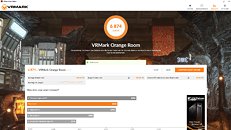Thursday, November 3rd 2016

Futuremark Announces VRMark, the Virtual Reality Benchmark
Futuremark, the Finnish software development company best known for its 3DMark benchmarking suite, has just announced the availability of another benchmark suite. Aptly named VRMark, this suite teste your system's ability to run VR games and experiences, since the performance required for VR is much higher than for typical PC games - just consider that the recommended frame-rate for an optimal VR experience stands at 90fps. Run VRMark to see if your PC has what it takes to deliver a great VR experience on the HTC Vive and Oculus Rift. VRMark benchmark tests run on your monitor, no headset required. If your PC passes, it's ready for the two most popular VR systems available today.The VRMark Orange Room benchmark shows the impressive level of detail that can be achieved on a PC that meets the recommended hardware requirements for the HTC Vive and Oculus Rift. If your PC passes this test, it's ready for the two most popular VR systems available today.
You can run the Orange Room as a benchmark to measure performance objectively, or as an Experience, which lets you judge the rendering quality with your own eyes.
You can run the Orange Room benchmark and experience on your monitor in Desktop mode, no headset required, or on a connected headset in HMD mode. VRMark supports Windows 10 64-bit, Windows 8.1 64-bit, as well as Windows 7 with Service Pack 1 64-bit, and there are two versions of it available: a free edition, VRMark Basic Edition, which includes the Orange Room benchmark and its experience mode; and a $19.99 Advanced Edition, which additionally unlocks access to the Blue Room benchmark for high-performance PCs, shows more detailed results and hardware monitoring charts, allows the exploration of both the Orange and Blue rooms in Experience mode, and adds the ability to customize your runs. Click the below link to download the Free version.DOWNLOAD: Futuremark VRMark v1.0.1227 (1007.3 MB)
You can run the Orange Room as a benchmark to measure performance objectively, or as an Experience, which lets you judge the rendering quality with your own eyes.
You can run the Orange Room benchmark and experience on your monitor in Desktop mode, no headset required, or on a connected headset in HMD mode. VRMark supports Windows 10 64-bit, Windows 8.1 64-bit, as well as Windows 7 with Service Pack 1 64-bit, and there are two versions of it available: a free edition, VRMark Basic Edition, which includes the Orange Room benchmark and its experience mode; and a $19.99 Advanced Edition, which additionally unlocks access to the Blue Room benchmark for high-performance PCs, shows more detailed results and hardware monitoring charts, allows the exploration of both the Orange and Blue rooms in Experience mode, and adds the ability to customize your runs. Click the below link to download the Free version.DOWNLOAD: Futuremark VRMark v1.0.1227 (1007.3 MB)






15 Comments on Futuremark Announces VRMark, the Virtual Reality Benchmark
these numbers are so weird, lower clocked lower watt broadwell with a 1060 so close to a skylake 1070
actually that haswell user mentioned 60% gpu usage
oh there's a 6600k 1080 that has 212fps, that doesnt seem right unless overclocked
so i guess that orange room is way too light & the blue room is too demanding (48fps for that haswell user)
Here is mine :)
www.3dmark.com/vrm/15828712
980Ti @ 1470Mhz, cpu 4770K @ 4.7Ghz
and default factory OC 1420mhz boost
www.3dmark.com/vrm/15833653
Generally what i've found (i'm running 2500K+GTX1080 @1440p myself) is that @ 1080p CPU will start bottlenecking heavily because 1080p is not that GPU bound. Moving to 1440p things get more intresting. Basicly @ 1440p and old CPU such as 2500K would bottleneck only in the following scenarios (or combination of these):
Multiplayer (more players=higher cpu load)
SLI/CF users (heavy CPU overhead when running multiple cards)
Single player games with high CPU requirements. ARMA3 is prime example. GTA V to a lesser extent.
But heavily GPU bound singleplayer games when using a sinlge GPU @1440p do not really care that much about CPU generation. Assuming you already have overclocked quadcore you won't see great FPS increases.
Benchmarks are always more sensitive to every little thing in a system. Take memory speed for example. Buying higher Mhz RAM does not increase your FPS (unless you're already CPU bound) but it makes great deal of difference in benchmark scores.
That being said: nothing lasts forever. Eventually newer components will start showing enough of a gap in many different scenarios and so upgrading is still a thing. Next year i will finally replace my 2500K.
you cant use AFR due to increased latency, both nv & amd are claiming special reduced latency modes for vr, supposedly less latency than on a regular monitor
two 1080s is quite the power, that would be 20-40fps in your past hardware on 3dmark reference (i can relate, 4870x2 in 2008 running vantage at 1200p, actually your 1080s should be in 4k for a real test)